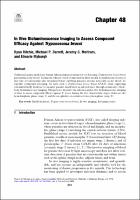Chapter 48 In Vivo Bioluminescence Imaging to Assess Compound Efficacy Against Trypanosoma brucei
Author(s)
Ritchie, Ryan
Barrett, Michael
Mottram, Jeremy
Myburgh, Elmarie
Collection
WellcomeLanguage
EnglishAbstract
Traditional animal models for human African trypanosomiasis rely on detecting Trypanosoma brucei brucei
parasitemia in the blood. Testing the efficacy of new compounds in these models is cumbersome because it
may take several months after treatment before surviving parasites become detectable in the blood. To
expedite compound screening, we have used a Trypanosoma brucei brucei GVR35 strain expressing
red-shifted firefly luciferase to monitor parasite distribution in infected mice through noninvasive wholebody
bioluminescence imaging. This protocol describes the infection and in vivo bioluminescence imaging
of mice to assess compound efficacy against T. brucei during the two characteristic stages of disease, the
hemolymphatic phase (stage 1) and the encephalitic or central nervous system phase (stage 2).
Book
TrypanosomatidsKeywords
Firefly luciferase, Trypanosoma brucei brucei, In vivo imaging, BioluminescenceDOI
10.1007/978-1-0716-0294-2_48ISBN
9781071602935, 9781071602966, 9781071602942Publisher
Springer NaturePublisher website
https://www.springernature.com/gp/products/booksPublication date and place
2020Grantor
Classification
Biology, life sciences


 Download
Download